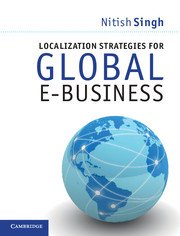Book contents
- Frontmatter
- Contents
- Figures
- Tables
- Preface
- Illustration credits and acknowledgements
- 1 Global e-commerce opportunities and challenges
- 2 International e-business expansion and market entry strategies
- 3 Global online consumer segmentation
- 4 Web globalization strategies
- 5 Developing international websites: internationalization
- 6 Effectively localizing international websites
- 7 Managing a web globalization value chain
- 8 Optimizing international websites
- 9 Assessing web globalization efforts
- 10 Strategic industry insights and emerging localization trends
- Web globalization resources
- Index
- References
3 - Global online consumer segmentation
Published online by Cambridge University Press: 05 June 2012
- Frontmatter
- Contents
- Figures
- Tables
- Preface
- Illustration credits and acknowledgements
- 1 Global e-commerce opportunities and challenges
- 2 International e-business expansion and market entry strategies
- 3 Global online consumer segmentation
- 4 Web globalization strategies
- 5 Developing international websites: internationalization
- 6 Effectively localizing international websites
- 7 Managing a web globalization value chain
- 8 Optimizing international websites
- 9 Assessing web globalization efforts
- 10 Strategic industry insights and emerging localization trends
- Web globalization resources
- Index
- References
Summary
Segmentation approaches
Global e-commerce opens a world of more than 2 billion consumers worldwide, but it is challenging for companies to effectively reach a significant number of these global consumers without an appropriate market segmentation strategy. Market segmentation is the process of dividing the overall market into subsets of buyers who share similar needs and wants under certain segmentation criteria. To be viable to a marketer, these market segments have to be identifiable, reachable, and measurable, and they must be big enough to justify targeting. Market segmentation helps companies effectively target their customer base and then develop product or brand positioning that relates to the needs of that particular market segment. Segmentation also helps companies differentiate their offerings from their competitors’.
In the context of global e-commerce, market segmentation relates not only to the products and services being sold on the website but also to how the website is localized on the basis of international consumer expectations. In the first half of the chapter I explore ways of segmenting traditional markets, and in the latter half I explore strategies related to segmenting international online consumers to better position company offerings, including international websites.
- Type
- Chapter
- Information
- Localization Strategies for Global E-Business , pp. 55 - 82Publisher: Cambridge University PressPrint publication year: 2011



